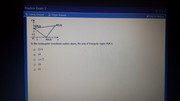
coordinate geometry
This topic has expert replies
- chacha0212
- Junior | Next Rank: 30 Posts
- Posts: 16
- Joined: Tue Sep 09, 2014 1:05 pm
- Followed by:1 members
GMAT/MBA Expert
- Brent@GMATPrepNow
- GMAT Instructor
- Posts: 16207
- Joined: Mon Dec 08, 2008 6:26 pm
- Location: Vancouver, BC
- Thanked: 5254 times
- Followed by:1268 members
- GMAT Score:770
- GMATGuruNY
- GMAT Instructor
- Posts: 15539
- Joined: Tue May 25, 2010 12:04 pm
- Location: New York, NY
- Thanked: 13060 times
- Followed by:1906 members
- GMAT Score:790
In the rectangular coordinate system below, the are of triangular region PQR is
12.5
14
10√2
16
25

The area of the rectangle drawn around triangle PQR = 7*4 = 28.
Since triangle PQR takes up less than half the rectangle, PQR < 14.
The correct answer is A.
Private tutor exclusively for the GMAT and GRE, with over 20 years of experience.
Followed here and elsewhere by over 1900 test-takers.
I have worked with students based in the US, Australia, Taiwan, China, Tajikistan, Kuwait, Saudi Arabia -- a long list of countries.
My students have been admitted to HBS, CBS, Tuck, Yale, Stern, Fuqua -- a long list of top programs.
As a tutor, I don't simply teach you how I would approach problems.
I unlock the best way for YOU to solve problems.
For more information, please email me (Mitch Hunt) at [email protected].
Student Review #1
Student Review #2
Student Review #3
Followed here and elsewhere by over 1900 test-takers.
I have worked with students based in the US, Australia, Taiwan, China, Tajikistan, Kuwait, Saudi Arabia -- a long list of countries.
My students have been admitted to HBS, CBS, Tuck, Yale, Stern, Fuqua -- a long list of top programs.
As a tutor, I don't simply teach you how I would approach problems.
I unlock the best way for YOU to solve problems.
For more information, please email me (Mitch Hunt) at [email protected].
Student Review #1
Student Review #2
Student Review #3
GMAT/MBA Expert
- ceilidh.erickson
- GMAT Instructor
- Posts: 2095
- Joined: Tue Dec 04, 2012 3:22 pm
- Thanked: 1443 times
- Followed by:247 members
Brent and Mitch's explanations are both great approaches, but I just wanted to extrapolate a more general rule from this... in geometry, especially in area problems, the GMAT will often give you shapes that are difficult (or even impossible) to calculate on their own. In these cases, it's most helpful to think in terms of NEGATIVE SPACE: calculate the area of a larger shape that's easier to find, then subtract away the pieces that you don't want, leaving the area of the shape that you're trying to find.
Ceilidh Erickson
EdM in Mind, Brain, and Education
Harvard Graduate School of Education
EdM in Mind, Brain, and Education
Harvard Graduate School of Education
-
Mathsbuddy
- Master | Next Rank: 500 Posts
- Posts: 447
- Joined: Fri Nov 08, 2013 7:25 am
- Thanked: 25 times
- Followed by:1 members
In this example, we can see that to travel from Q to P, we go [4,-3]
and to go from P to R, we go [3,4]
Hence line QP is perpendicular to PR.
In other words, QPR is a right-angle triangle.
Using 3-4-5, we also see that QP = PR = 5
So the area is simply 5x5/2 = 12.5
and to go from P to R, we go [3,4]
Hence line QP is perpendicular to PR.
In other words, QPR is a right-angle triangle.
Using 3-4-5, we also see that QP = PR = 5
So the area is simply 5x5/2 = 12.5
-
Matt@VeritasPrep
- GMAT Instructor
- Posts: 2630
- Joined: Wed Sep 12, 2012 3:32 pm
- Location: East Bay all the way
- Thanked: 625 times
- Followed by:119 members
- GMAT Score:780
One last cool note about this problem. Suppose we have the triangle as shown below.

Since each of the other triangles is a 3-4-5, each other triangle must have angles of a and b, whatever those are. We know that a + b = 90, and we also know that 180 - (a+b) = the third angle of the blue triangle, since a, b, and that third angle are on a line.
Hence the blue triangle is a right triangle, since 180-(a+b) = 90°. That means that it has a base of 5 and a height of 5, and its area = 5*5/2 = 12.5.

Since each of the other triangles is a 3-4-5, each other triangle must have angles of a and b, whatever those are. We know that a + b = 90, and we also know that 180 - (a+b) = the third angle of the blue triangle, since a, b, and that third angle are on a line.
Hence the blue triangle is a right triangle, since 180-(a+b) = 90°. That means that it has a base of 5 and a height of 5, and its area = 5*5/2 = 12.5.




















